Set apart from its more serene frog cousins, the African bullfrog brings a bad boy image to the pond.
Frogs are known for their unimposing nature. They appear content with simply splashing around in shallow pools and leaping from lily pad to log.
Frogs are not associated with aggression or violence. Yet, not all members of the frog fraternity are quite so passive. Enter, the African bullfrog.
Much larger in scale and stature than its amphibious aunts and uncles, the African bullfrog will not be winning a Nobel Peace prize. This is a fighting frog and here is its full story.
The African Bullfrog – Built for Destruction and Durability
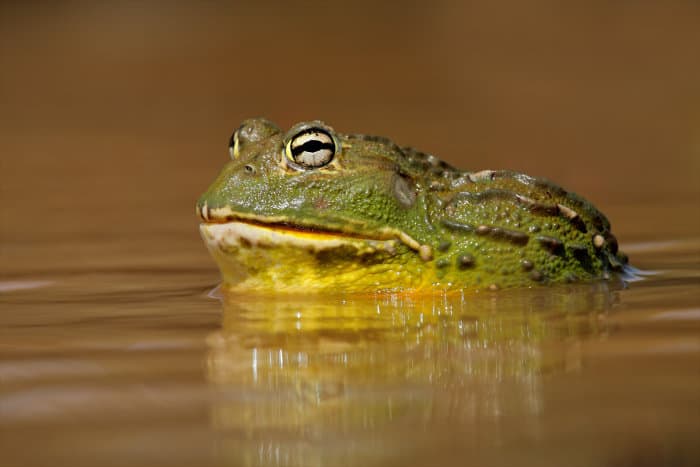
Dwarfing its more commonly known counterparts, the African bullfrog is a green silhouette of strong muscle and tendons.
You can easily compare it with the fighting stance of a crouching sumo wrestler. It has an enormous ass and a round, bulging shape. This is for good reason, because the African bullfrog can challenge and charge at the slightest sign of provocation.
Weighing as much as 2 kg, the male African bullfrog is bigger than almost all other frogs. It is less happy hopper, and more deadly destroyer.
The African bullfrog’s attack-ready stance takes the form of a barrel-shaped body and an ability to hurtle itself at a rival. Its round shape is complemented by two hydraulic-like levers for back legs.
These limbs can propel the African bullfrog as far as two metres in one single jump! Launching itself at full speed, this frog can easily put a sizeable dent in any rival.
A frog that hibernates
The African bullfrog takes hibernation to a new level of extremity and spends the driest part of the year in a subterranean chamber.
It lies completely dormant in a self-made cocoon of old skin cells, slowing or totally shutting down all its biological processes to conserve energy.
During this time, the African bullfrog will appear quite lifeless. It reduces all signs of existence to an extremely thin rate of respiration.
Though it isn’t the only creature to go through this hibernation process it is one of the most adept. For months on end, the African bullfrog survives on the remnants of water and other liquids stored in its vital organs, particularly its bladder.
After months of inactivity, nature’s ecological alarm clock kicks in. Rainwater seeps through the soil to permeate the African bullfrog’s self-structured pod. This breach of its cocoon is the welcome sign that it’s time for the bullfrog to wake from slumber.
African Bullfrogs Returning from Hibernation
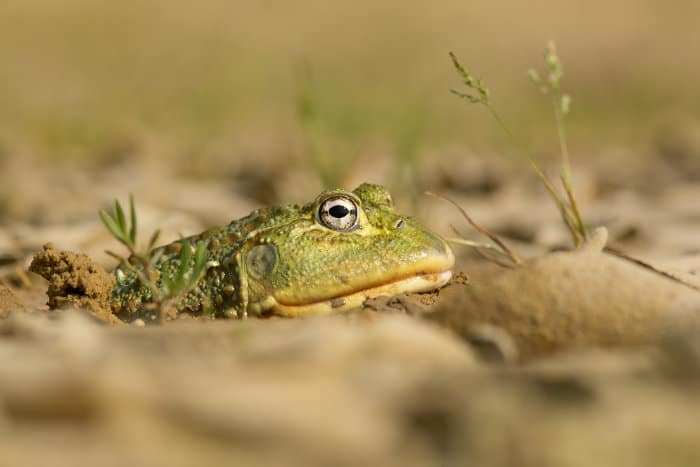
Now comes the most important time in a bullfrog’s annual cycle. It’s time to return from subterranean hideouts to the African savanna. It’s time to feast and fight for a mate!
Fighting
Having spent the preceding months in total solitary seclusion, the African bullfrog has two pressing matters on its mind – munching and mating.
It emerges from the muddy mess that has served as its short-term mausoleum. The African bullfrog must now prove its physical worth against the other marauding males of its tribe. Why? Because size and fighting ability is how to find a mate.
It stretches and shakes off the stiffness. It heaves its hefty frame forward. Plopping into a pool of water its senses start to sharpen.
Before any food can be consumed or any females can be fertilised, an exhibition of brawn is expected. The African bullfrog must show not the slightest hint of fear.
A willingness to strut and swagger into the open will serve as an intimidating sight to others who also want to claim territory and a mate.
Taking on all comers, the male African bullfrog launches itself forward towards any opposition males who dare to approach. This amphibious giant will risk personal injury to land a telling strike on a rival.
After the initial attack leap, African bullfrogs reveal dagger-like pincers positioned in the gum of their lower jaw. These are known as adenoids. When in battle, adenoids are used to perforate the soft lip skin of an adversary.
Such combat sees a repetitive clamping of mouth on mouth that appears to be the most sinister of French kisses. It’s enough to make a bullfrog challenger lose all taste for battle. The victor will enjoy the adoration of nearby females.
Eating – African bullfrogs have a broad omnivorous diet
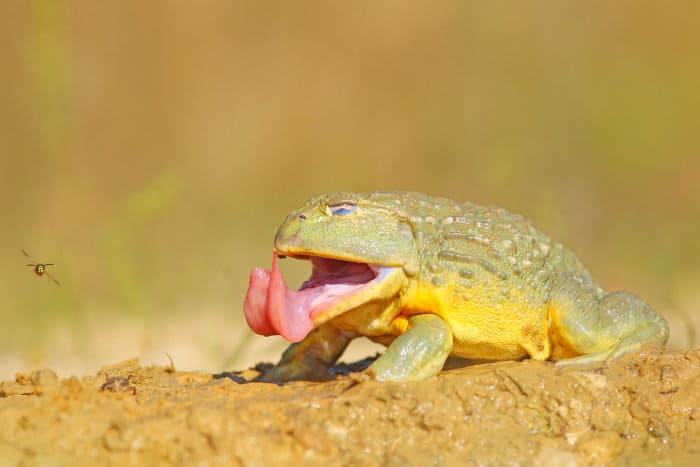
As well as fighting and mating, bullfrogs need to eat, especially after surviving so long in hibernation.
It is not a picky eater. The African bullfrog swallows almost anything that fits into its trapdoor of a mouth. Like a toddler with a piece of Lego, if it’s small enough, it’s going in.
African bullfrogs have been known to dine upon insects, small rodents, tiny birds, other amphibians and aquatic creatures.
Due to certain cannibalistic tendencies, it isn’t uncommon for the African bullfrog to eat others of its kind. They have even been known to nibble on the tadpoles of rival males!
After months in an underground cave, ponds and pools provide a healthy supply of nutrients. African bullfrogs can grow stronger simply by absorbing the water they now live in.
Mating

Triumphant male will waste little time mounting and mating with a nearby female.
A rarity in the amphibian community, female African bullfrogs are only half the size of their male suitors. This is best illustrated during mating season when a female bullfrog can be pushed to near exhaustion by a much larger male.
Without so much as a ‘how do you do’, the male African bullfrog climbs aboard his miniature partner and commences thrusting. The recipient of this newfound affection finds herself a captive audience to the breeding process. But she is a willing participant. She will watch the battles between males and seek to mate with the strongest bullfrog.
The male bullfrog only stops when the number of fertilised eggs numbers in the thousands. And here is where this story about an aggressive, fighting frog takes an unexpected turn.
Male African Bullfrogs Show Remarkable Paternal Responsibility
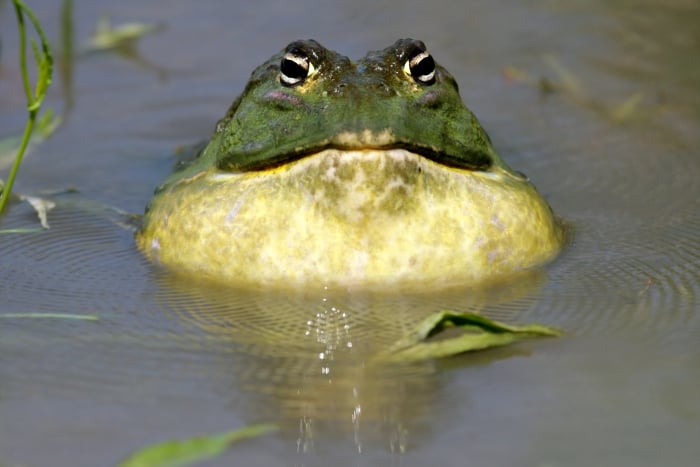
Female bullfrogs have a gestation period of just 48 hours, so the father-to-be has little time to adjust or prepare for the parental challenge ahead. Unbelievably, males are responsible for raising, protecting and nurturing their horde of tadpole offspring.
The female African bullfrog’s job is done. Her duty of care is simply to choose a mate and release her fertilised eggs into the pond. After this she makes herself scarce.
The father begins a tadpole vigil which will last a minimum of three weeks. He must protect his offspring at all times. Then the tadpoles – those that have survived – will metamorphose into mini versions of the father and begin to fend for themselves.
This period from hatching to metamorphosis is fraught with all manner of risk and danger.
In the early stages, the threat of potential predators is not a primary concern for the bullfrog father. A major concern for African bullfrog spawn is the tropical sun and the heat it generates.
The caring father
The pools in which the tadpoles congregate can evaporate and recede. This is just one reason the best time for these frogs to breed is the start of rainy season. Time it wrong and the tadpoles must huddle tightly in retreating water. When they are packed too close, the African bullfrog must come up with an innovative solution for his sprawling shawl.
The fully grown African bullfrog will use its heavily pointed snout to bulldoze a path between different pools. This will either allow the trapped tadpoles to spread out and breathe, or cause water to gush between pools and ensure the family’s survival.
Protecting his young is an intensive undertaking for the male African bullfrog. This level of dedication and devotion to his children treats us to an unseen side of warmth and compassion. These character traits contradict the forceful way in which he mates and the merciless manner in which he attacks male competition.
More Bull Than Frog?
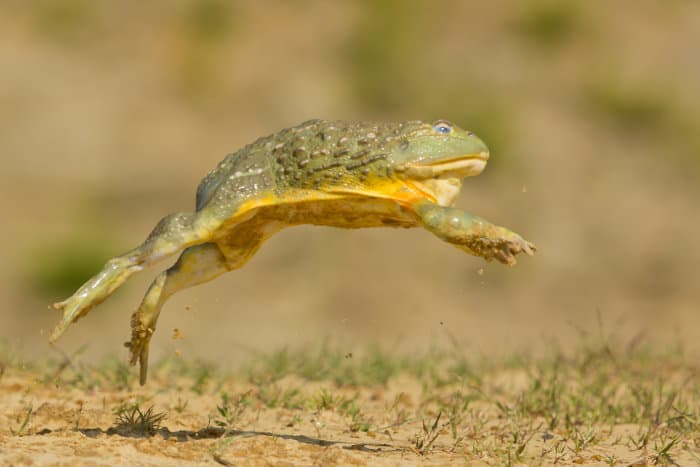
So what do you think? Is the African bullfrog a violent bully or does this remarkable creature have an unwarranted reputation?
Sure, these frogs like to fight. But after fighting for a mate they are one of the most caring single parents in the animal kingdom!


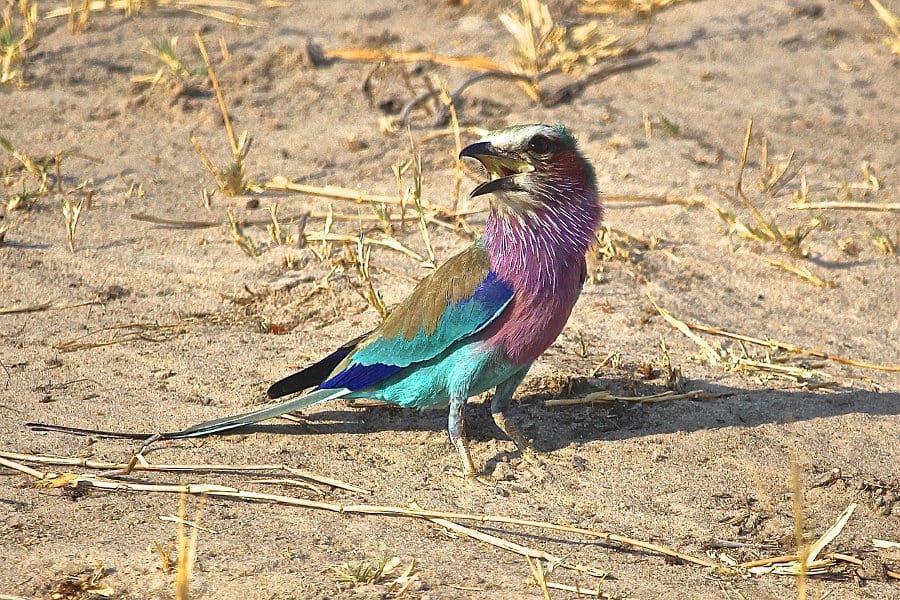
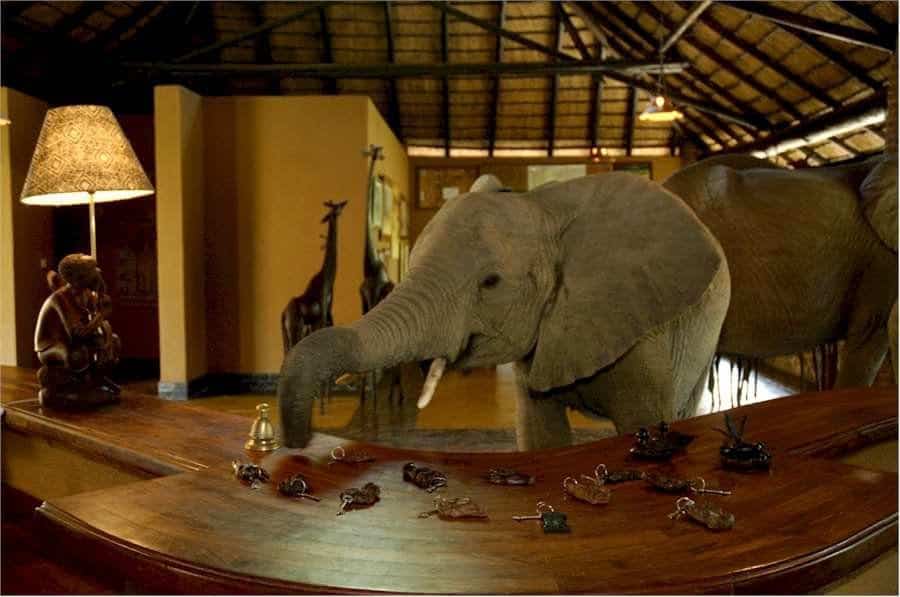
Harare 1980s. Chinese construction crew building Sports Stadium almost obliterated the bullfrog population. I don’t know if they recovered!
Hi Derek,
What a pity, I was not aware of this story.
Let’s hope so indeed!
Thanks for your share,
Michael